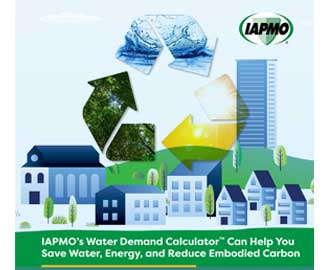Ontario, Calif. — Using the International Association of Plumbing and Mechanical Officials’ (IAPMO) Water Demand Calculator™ as an alternative to sizing methods in traditional plumbing codes can result in energy, carbon and water savings with no change to how residents use plumbing fixtures in their homes every day, an analysis by Arup, a global collective of designers, consultants and experts dedicated to sustainable development, has found.
IAPMO commissioned Arup to analyze and better understand the Water Demand Calculator’s potential for sustainability savings. Arup compared the Water Demand Calculator with the Hunter’s Curve method found standard in both the Uniform Plumbing Code (UPC®) and the International Plumbing Code (IPC®) for sizing domestic hot water systems in four residential-use cases. The analysis included a single-family home, and six-unit, 45-unit and high-rise multifamily residences.
Arup’s study found that when the Water Demand Calculator is used for domestic water design for residential buildings instead of the Hunter’s Curve sizing methods, there are resulting operational energy and embodied carbon savings in all four of the use cases, as well as water savings in the non-circulating units. Water savings were demonstrated through minimized time to tap using the Water Demand Calculator sizing and range from 450 gallons to 71,000 gallons annually depending on the building size.
A single-family unit prototype showed annual water savings of 450 gallons, while high-rise residential buildings show savings in operational carbon between 73 and 84% for booster pumps and embodied carbon savings ranging from 20% to 41%. Using the Water Demand Calculator instead of the Hunter’s Curve method to size domestic water systems in high-rise residential buildings shows savings of operational carbon ranging from 2,000 to nearly 24,000 pounds of carbon dioxide per high-rise residential building, depending on grid emissions at the project site. Additionally, a reduction in pipe sizing allows for reduced heat loss through pipes.
”The Water Demand Calculator is a tool for its age,” IAPMO Vice President of Technical Services and Research Christoph Lohr, P.E., said. “With concerns of energy reduction and water savings being top of mind for many regions in the United States and the world, having the latest methodology to meet goals is vital. We greatly appreciate Arup providing IAPMO with a third-party evaluation of the potential for the Water Demand Calculator to help meet sustainability goals.”
The Water Demand Calculator is the first significant update for water pipe sizing in buildings since Hunter’s Curve was developed more than 80 years ago. The Water Demand Calculator predicts peak water demand for single- and multifamily dwellings and removes the need for assigning fixture units to plumbing fixtures and corresponding to Hunter’s probability curve. Instead, it directly calculates peak demand using algorithms based on the building size.
Contained within Appendix M of the 2021 Uniform Plumbing Code (UPC®) and free to download, version 2.1 of the Water Demand Calculator addresses water quality issues attributed to lower flows in oversized premise plumbing while simultaneously using less water and energy, representing the most impactful innovation in pipe sizing in nearly a century. It is the result of a multiyear effort to develop a new statistically based pipe sizing method stemming from a need to address profound water safety and wasted water and energy concerns resulting from oversized water supply pipes in homes and buildings.
The entire Arup report may be viewed HERE.
IAPMO’s Water Demand Calculator may be downloaded HERE. For more information, contact Dan Cole at dan.cole@iapmo.org.

IAPMO
IAPMO develops and publishes the Uniform Plumbing Code®,the most widely recognized code of practice used by the plumbing industry worldwide; Uniform Mechanical Code®; Uniform Swimming Pool, Spa and Hot Tub Code®; and Uniform Solar Energy, Hydronics and Geothermal Code™ — the only plumbing, mechanical, solar energy and swimming pool codes designated by ANSI as American National Standards — and the Water Efficiency Standard (WE-Stand)™. IAPMO works with government, contractors, labor force, and manufacturers to produce product standards, technical manuals, personnel certification/educational programs and additional resources in order to meet the ever-evolving demands of the industry in protecting public health and safety.
Last modified: June 13, 2023

